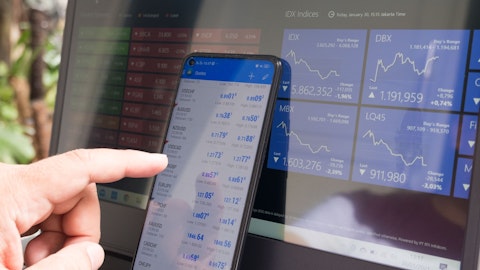I’m sorry about this. I think that what we’re seeing on the cat excessive loss right now is that people are buying more on top because they also are appreciating and evaluating the total level of exposure capacity needed in PML. So I think what people — what we’re seeing is people trading away the bottom layers and buying more on top. And I think we’re going to see that a bit more as we go into 2024, which totally makes sense.
Cave Montazeri: Okay. My follow-up question is on mortgage insurance. Now you had been kind of pulling back even before activity came to a halt. But if the fed rate cuts, if they do come lead to a pickup in the U.S. activity in the housing market, would you be happy to grow in line with the market or should we expect you to kind of grow maybe less stuff in the market?
Marc Grandisson: Yes, mortgage, absolutely, we would be. I think that — yes, the answer is we would be more than happy. We have capacity, capital to be able to deploy and I think we would be very, very pleased to do more. Absolutely.
François Morin: And as you know it’s been a very good market, very rationale market. So obviously, the rates were able to charge for the risk will matter and where we — how we position the book. But in terms of our ability to grow, when we get originations go up, we’re absolutely capable and willing to do that.
Operator: Thank you. One more for our next question. Our next question comes from the line of David Motemaden from Evercore.
David Motemaden: Hi, thanks. Good morning, and apologies, I haven’t been hearing the answers, so not sure if you’ve answered any of these already. But just Marc, you spoke a little bit at the beginning of the call about the need or the strategy to lean in at the early part of a hard market. I guess how do you manage that with potential false starts? It sounds like casualty market on the reinsurance side hasn’t hardened as quickly as you’ve expected. But how do you manage that just internally between writing business that might be hardening, but not totally to where you think it should go and the potential for false starts?
Marc Grandisson: It’s a very, very good question. And I think this is where the Arch comes into play; right, in experience and knowing some of the markings of a hardening market, a lot of it also has to do with things you won’t hear, right, is our underwriting team sitting down with clients, potential clients, and try to understand, how do you think about the risk? I’ve talked about reinsurance now specifically, and we also have a very healthy database like everyone else, but we also have our own, and we have our own view of claims and how it develops. And we have, again, experience over 20 years of data and information. And this is what we use to hopefully get the compass in the right order. But if I can’t be sitting here and tell you and pretend that we’re going to get everything right 100%, it’s a little bit more art and science.
And I would think that as I’m getting older, the psychology of the market is becoming way more important, feels to me, than even the numbers. And that’s probably what compelled me or what made me ask the team to lean into 2019. And you don’t know for a fact until it’s done, but there are markings or signs in the overall market that help you and support your decision to lean into it heavily. That’s all I can tell you, because it’s really not a one for one. There’s no like one number one spreadsheet I can point to that will tell you the answer.
François Morin: And the one thing I’ll add quickly, David, is the reverse is true as well. When the market goes soft, sometimes you pull back and you might go back too early. But that’s the game we play. That’s the business we’re in, and we do our best. Again, we’re never going to time it perfectly, but what matters more is the direction of it. And then over the cycle, we think we should come out ahead.
David Motemaden: Yes, no, understood. That makes sense. And then Marc, you had mentioned that at 1/1 the property market continued to improve, property cat reinsurance market. I guess as we sit here today and sort of looking forward at the sustainability of that as we move through 2024, what’s your view now on that and the growth opportunities in property cat?
Marc Grandisson: First, we have no growth constraints per se. We can grow. As you know, François mentioned, the value of our PML is 9.2%, so we have room to grow there. I think the question about where it’s going to go is so difficult to answer because it’s dependent on what happens and what kind of activity we see this year. But if I would probably point to you to the 2006 turn of the market in 2007, that’s probably a better way to think about it. 2006, or 2007, 2007 was a better year than 2006. And 2008, 2009, and 2010 were really, really good years in property because the market, as we all know, goes up really, really quickly but does not go down in one fell swoop. You’ve got a lot of sustainability in the returns for a little while. It takes a while before things get too close to the line or below the line of what we want to adjust. So we have some runway in front of us.
David Motemaden: Got it. Understood. And I know in the past you’ve said alternative capital, or ILS can — has the ability to swing the market one way or the other. What exactly are you seeing there?
Marc Grandisson: What we hear is there’s still a very high demand for returns which prevents or high demand for returns and also still some level of skepticism that might change, but we’ll see where that goes. But clearly, right now, at the margin, some increases, but it’s not the wave that we saw probably in 2014, 2015, 2016, nowhere near that.
Operator: Thank you. Arch Capital Group answers have been captured and will be available in the replay. I would now like to turn the conference over to Mr. Marc Grandisson for closing remarks.
Marc Grandisson: First of all, I want to apologize thoroughly for the call quality and the dropping in and out. There will be a recording available for replay, and you know, our two esteemed colleagues, Don and Vinay will be available to follow-up obviously. I want to thank you for listening to our call and I’m looking forward to speak to you again in April. Thank you very much.
Operator: Ladies and gentlemen, thank you for participating in today’s conference. This concludes the program. You may all disconnect.
Follow Arch Capital Group Ltd. (NASDAQ:ACGL)
Follow Arch Capital Group Ltd. (NASDAQ:ACGL)
Receive real-time insider trading and news alerts





